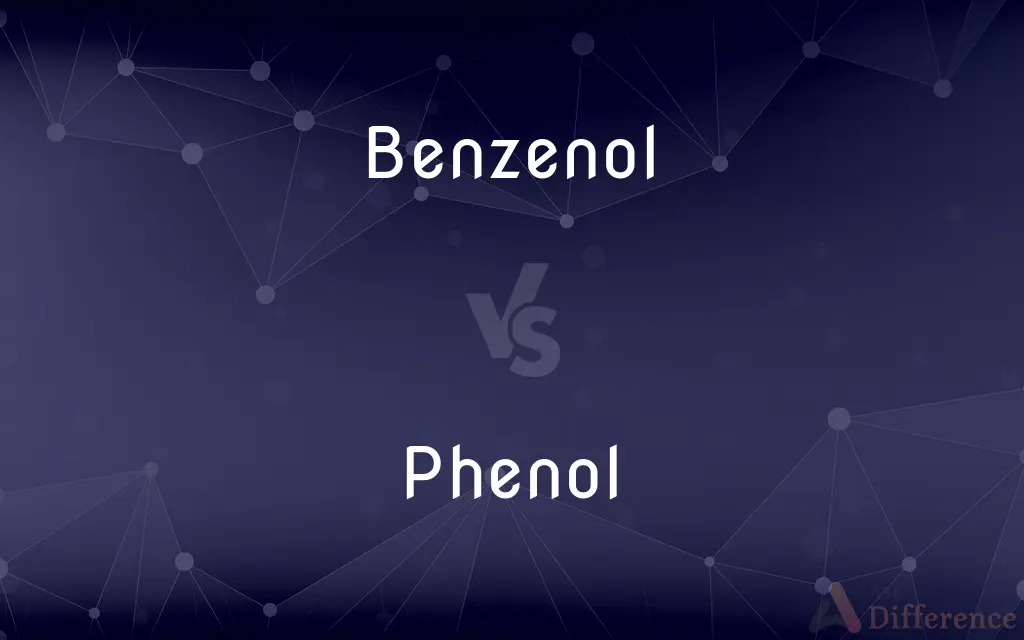Benzenol vs. Phenol — What's the Difference?
Edited by Tayyaba Rehman — By Fiza Rafique — Updated on April 2, 2024
Benzenol and Phenol refer to the same chemical compound, with Phenol being the more commonly used name.

Difference Between Benzenol and Phenol
Table of Contents
ADVERTISEMENT
Key Differences
Benzenol and Phenol are two terms for the same chemical substance, with the molecular formula C6H5OH, consisting of a benzene ring bonded to a hydroxyl group. While "Phenol" is the term more widely recognized and used in both scientific literature and industry, "Benzenol" is a less common name that emphasizes the compound's structural relationship to benzene. Both names refer to this aromatic organic compound known for its antiseptic properties, but Phenol is the preferred nomenclature in most contexts.
The use of the term Phenol over Benzenol highlights the substance's historical and practical significance, particularly its role in medical and industrial applications. Phenol's antiseptic properties were historically significant in surgery before the advent of more modern antiseptics. On the other hand, Benzenol, as a name, is rarely used but can be seen in educational contexts to emphasize the compound's chemical structure, showing its derivation from benzene.
Phenol is known for its versatility and is used in the manufacture of a wide range of chemical products, including plastics, pharmaceuticals, and dyes. While both names refer to the same compound, the broader applications and chemical reactions of this compound are typically studied and referenced under the name Phenol.
In teaching and chemical nomenclature discussions, the difference in naming can serve as an example of how organic compounds can be named based on their structure (Benzenol) or their functional groups and historical usage (Phenol). This distinction, while subtle, emphasizes the importance of standardized naming conventions in chemistry.
Despite the difference in terminology, the compound's properties and applications remain the same. Phenol's ability to participate in various chemical reactions makes it a fundamental substance in organic chemistry, serving as a precursor to numerous chemical compounds and materials.
ADVERTISEMENT
Comparison Chart
Nomenclature
Less common name emphasizing structural relation to benzene.
More widely used and recognized term.
Historical Significance
Rarely used, more academic.
Historically significant, especially in medical antiseptics.
Applications
Same as Phenol, used in plastics, pharmaceuticals, dyes.
Used in plastics, pharmaceuticals, dyes, and more.
Chemical Reactions
Participates in the same chemical reactions as Phenol.
Key precursor in various organic syntheses.
Usage
Mostly educational to highlight chemical structure.
Preferred in scientific literature and industry.
Compare with Definitions
Benzenol
Rarely used compared to Phenol.
You might encounter Benzenol in academic texts focusing on chemical nomenclature.
Phenol
Fundamental in organic chemistry.
Phenol's reactivity makes it crucial in various chemical syntheses.
Benzenol
Same as Phenol, C6H5OH.
Benzenol, or Phenol, has a simple formula but significant industrial and medical applications.
Phenol
Used in numerous chemical products.
Phenol is a precursor in the synthesis of many dyes and drugs.
Benzenol
A name highlighting its chemical structure relation to benzene.
Benzenol is derived from benzene by substituting one hydrogen atom with a hydroxyl group.
Phenol
Significant in the development of antiseptics.
Phenol was a groundbreaking antiseptic in surgical procedures.
Benzenol
Used in teaching to explain nomenclature.
In organic chemistry, Benzenol serves as an example of naming based on structural derivation.
Phenol
Used in most scientific and industrial contexts.
The term Phenol is preferred in literature over Benzenol.
Benzenol
Identical uses as Phenol.
Benzenol is also used in producing various pharmaceuticals and plastics.
Phenol
Widely recognized and used term.
Phenol is known for its antiseptic properties and industrial applications.
Benzenol
(organic compound) phenol
Phenol
Phenol (also called carbolic acid) is an aromatic organic compound with the molecular formula C6H5OH. It is a white crystalline solid that is volatile. The molecule consists of a phenyl group (−C6H5) bonded to a hydroxy group (−OH).
Phenol
A mildly acidic toxic white crystalline solid obtained from coal tar and used in chemical manufacture, and in dilute form (under the name carbolic) as a disinfectant.
Phenol
A caustic, poisonous, white crystalline compound, C6H6O, derived from benzene and used in resins, plastics, and pharmaceuticals and in dilute form as a disinfectant. Also called carbolic acid.
Phenol
Any of a class of aromatic organic compounds having at least one hydroxyl group attached directly to the benzene ring.
Phenol
A caustic, poisonous, white crystalline compound, C6H5OH, derived from benzene and used in resins, plastics, and pharmaceuticals and in dilute form as a disinfectant and antiseptic; once called carbolic acid
Phenol
Any of a class of aromatic organic compounds having at least one hydroxyl group attached directly to the benzene ring (or other aromatic ring)
Phenol
A white or pinkish crystalline substance, C6H5OH, produced by the destructive distillation of many organic bodies, as wood, coal, etc., and obtained from the heavy oil from coal tar.
Phenol
Any one of the series of hydroxyl derivatives of which phenol proper is the type.
Phenol
Any of a class of weakly acidic organic compounds; molecule contains one or more hydroxyl groups
Phenol
A toxic white soluble crystalline acidic derivative of benzene; used in manufacturing and as a disinfectant and antiseptic; poisonous if taken internally
Common Curiosities
What are the main applications of Phenol?
Phenol is used in the manufacture of plastics, pharmaceuticals, dyes, and as a precursor in various chemical syntheses.
How did Phenol gain historical significance?
Phenol gained historical significance through its early use as an antiseptic in medical surgeries.
Can the term Benzenol be used interchangeably with Phenol?
While it can be used interchangeably in terms of chemical identity, Phenol is the preferred term in most contexts.
Why is Phenol more commonly used than Benzenol?
Phenol is more widely used due to its historical significance and established presence in scientific literature and industry.
Are Benzenol and Phenol the same compound?
Yes, Benzenol and Phenol refer to the same chemical compound, C6H5OH.
Why might educators use the term Benzenol instead of Phenol?
Educators might use Benzenol to emphasize the structural relationship of the compound to benzene, aiding in teaching organic chemistry nomenclature.
Can Phenol be found in nature?
Yes, Phenol and its derivatives are found in nature, particularly in the breakdown products of organic matter and in some plants and microorganisms.
What role does Phenol play in organic chemistry?
Phenol serves as a key starting material for the synthesis of various organic compounds, highlighting its importance in chemical reactions and industrial applications.
In what industries is Phenol particularly important?
Phenol is crucial in the plastics industry for making polycarbonates and epoxies, in pharmaceuticals for drug manufacture, and in the production of dyes and resins.
What safety precautions are necessary when handling Phenol?
Due to its corrosive nature and toxicity, handling Phenol requires protective gear, adequate ventilation, and adherence to safety guidelines to prevent exposure.
How is Phenol produced industrially?
Industrially, Phenol is primarily produced through the cumene process, which involves the oxidation and subsequent acid-catalyzed cleavage of cumene hydroperoxide.
What environmental concerns are associated with Phenol?
Phenol can pose environmental risks due to its toxicity to aquatic life and potential to contaminate water sources, necessitating careful handling and disposal.
How does Phenol's structure affect its chemical properties?
Phenol's aromatic structure and hydroxyl group contribute to its acidity and reactivity, making it versatile in organic synthesis and industrial applications.
How does the presence of a hydroxyl group in Phenol influence its chemistry?
The hydroxyl group in Phenol increases its acidity compared to hydrocarbons, allowing it to undergo reactions typical of both phenols and alcohols.
What are some common uses of Phenol in everyday products?
Phenol is used in the production of disinfectants, antiseptics, and some consumer products like mouthwashes and sore throat lozenges due to its antimicrobial properties.
Share Your Discovery

Previous Comparison
Moderately vs. Moderate
Next Comparison
Impressionable vs. ImpressibleAuthor Spotlight
Written by
Fiza RafiqueFiza Rafique is a skilled content writer at AskDifference.com, where she meticulously refines and enhances written pieces. Drawing from her vast editorial expertise, Fiza ensures clarity, accuracy, and precision in every article. Passionate about language, she continually seeks to elevate the quality of content for readers worldwide.
Edited by
Tayyaba RehmanTayyaba Rehman is a distinguished writer, currently serving as a primary contributor to askdifference.com. As a researcher in semantics and etymology, Tayyaba's passion for the complexity of languages and their distinctions has found a perfect home on the platform. Tayyaba delves into the intricacies of language, distinguishing between commonly confused words and phrases, thereby providing clarity for readers worldwide.












































